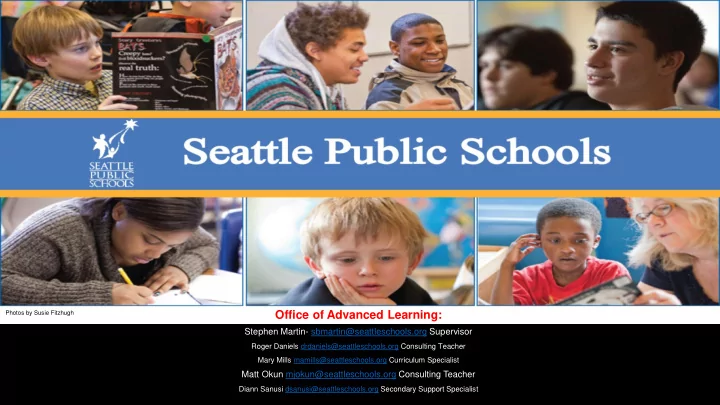

Photos by Susie Fitzhugh Office of Advanced Learning: Stephen Martin- sbmartin@seattleschools.org Supervisor Roger Daniels drdaniels@seattleschools.org Consulting Teacher Mary Mills mamills@seattleschools.org Curriculum Specialist Matt Okun mjokun@seattleschools.org Consulting Teacher Diann Sanusi dsanusi@seattleschools.org Secondary Support Specialist
How to Address Disproportionality in HC Programs
Highly Capable (HC) or “Gifted” programs in urban centers have historically suffered from an under-representation of students of color; especially those of African-American, Hispanic and Native American heritage. SPS and many Districts nationwide have experimented with a variety of approaches to combat disproportionality especially for culturally, linguistically, economically diverse (CLED) populations.
Disproportionality in HC in SPS White = OVER-represented African American= UNDER-represented Hispanic= UNDER-represented Asian= UNDER-represented
Discuss with your elbow partner/partners: What are some of the causes of disproportionality in HiCap programs?
Disproportionality in Seattle In Seattle, CHALLENGES Include: • Changes in District demographics • High numbers of referrals from certain demographic groups • Low “ “ “ “ “ “ “ • Negative attitudes/preconceptions of • Teachers • Administrators • Parents
Statistics: Nationwide: • 7.47 percent of all White students • 9.9 percent of Asian students • 3.04 percent of African American students • 3.57 percent of Hispanic students • 4.86 percent of American Indian students are identified as gifted. Data from National Academy of Sciences http://www.nea.org/assets/docs/HE/EW-TruthInLabeling.pdf
Statistics: HC Students by Race • 7.47 percent of all White students nationally • In Seattle 12.5% • 3.04 percent of African American students nationally • In Seattle, less than 1%
HC program eligibility: Approximately • 70% White • 10% Asian • 10% Multiracial • 10% African American, Native American, Pacific Islander, and Hispanic combined
Total SPS Enrollment by Grade and Race District Enrollment by Fed7 Code School Fed7 Year 2011 2012 2013 2014 2015 Asian 10012 8782 8529 8254 7915 Black 9904 8822 8737 8530 8216 Hispanic 5950 6266 6512 6494 6419 Multi-Racial 3293 3790 4366 4822 Native American 703 505 420 377 337 None Stated 2 1 29 Pacific Island 68 262 268 248 247 White 21857 21934 22753 23690 24368 Grand Total 48496 49864 51010 51988 52324
2015 2015-16 Total SPS Enrollment: 52,3 ,324 White = 46% and RISING UP 10% past 5 years Multiracial= 9% and RISING UP 50% past 5 years African American= 15% and FALLING DOWN 15% “ “ “ Asian= 15% and FALLING DOWN 21% “ “ “ Hispanic= 12% and FALLING DOWN 7% “ “ “
School Year 15-16 % of Total SPS % Referred to AL % HC + AL eligible Enrollment Asian 15.1 10.2 12.6 Black 15.7 3.6 2.5 Hispanic 12.3 4.6 4.6 Multiracial 9.2 12.9 10.5 White 45.7 66 69.6
Growth In AL Eligibility Numbers 10000 9000 8000 7000 6000 5000 4000 3000 2000 1000 0 ABHIMP White ALL 2011 2012 2013 2014 2015 2016
80.00% 70.00% 60.00% 50.00% 40.00% 30.00% 20.00% 10.00% 0.00% ABHIMP White 2011 2012 2013 2014 2015 2016
Percentage of White Students vs. Students of Color in AL 71.7 70.7 70.2 70.2 69.5 68.8 31.2 30.5 29.8 29.8 29.3 28.2 2011 2102 2013 2014 2015 2016 White Non-white
Growth Data by Race From SY 15-16 to 16-17 % increase in % increase in HC AL + HC Grades 1-8 Grades 1-12 2 4 Asian 11 9 Black 7 12 Hispanic 11 13 Multiracial 4 5 White 5 6 TOTAL
. Newly Id Identified HC students in in 14-15 and 15-16 16 Referred/ HC Eligible HC eligible % HC eligible HC eligible incl. incl. Tested appeal appeal % White14-15 3486 366 10.5% 529 15.2% African Am 249 12 4.8% 14 5.6% 14-15 White 15-16 2764 216 7.8% 383 13.9% African Am 167 * 3.6% * 4.2% 15-16
How Has SPS Begun to Address Disproportionality in HC Programs? 1. Identification 2. Program Model/Services 3. Professional Development 4. Community Engagement and Communication
1. Identification a) Each and every referred student tests for eligibility; there are no longer any pre- qualifications at all b) 2nd grade “universal testing” using the CogAT screening form at all Title One elementary schools c) Invitations for continued screening extended to parents of students demonstrating high potential on the CogAT screening form (K-2) d) Parent rating scale is 1 of 5 or more “data points” in eligibility process e) “Special consideration” in the eligibility process as noted in our Superintendent Procedures and practiced by the MSC (multidisciplinary selection committee) f) Collaboration with the Rainier Scholars Program so that we can contact their applicants to generate referrals for previously unidentified high potential students of color
2. Program Models/Services a) Highly Capable Cohort (HCC) = Self-contained (Approx. 75% of eligible HC students) b) Served at neighborhood school (Approx. 25% of eligible HC students) 3 Elementary Schools are HCC sites: One is 100% HCC 4 Middle Schools are HCC sites: All 4 are Comprehensive MS 2 High Schools are HCC sites: Both are Comprehensive HS c) HC and Spectrum Eligible students served at every school through Advanced Learning Opportunities (ALO)
3. Professional Development a) Differentiation workshops at the central office & satellite sites b) Presentations on culturally responsive pedagogy, as well as the relationship between social justice and SPS HiCap programs; offered and implemented at the building level based on collaboration with the SPS Dept. of Equity and Race Relations c) Outreach to school principals and teachers through workshops and conferences to expose them to the characteristics of gifted students to enhance identification skills d) Direct assistance through curriculum alignment and planning sessions with teachers
4. Community Engagement and Communication a) Eligibility forms and first day packet announcement (translations in 7-9 languages) b) Website information, videos, and announcements disseminated to local and social media outlets c) Site visits and PowerPoint disseminated re: identification and referral d) AL representation on the Equity and Race Advisory Committee (ERAC) e) AL representation on the Southeast Seattle Education Consortium (SESEC) f) AL representation at PTSA meetings, Community Meetings, and Equity Panels at school sites
How Has SPS Begun to Address Disproportionality in HC Programs? 1. Identification 2. Program Model/Services 3. Professional Development 4. Community Engagement and Communication
Recommend
More recommend